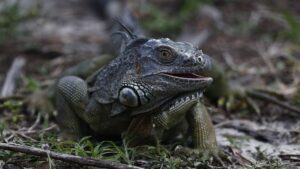Florida Iguanas
Florida iguanas can grow to a size of up to five feet and weigh up to three pounds. They are invasive species that are not threatened by humans, although they can bite and temporarily incapacitate humans. However, if you come into contact with one, they will usually recover.
The green iguana is one of the largest species of iguana in the world. Males can reach a length of six feet and weigh about 17 pounds, while females can reach a size of five feet. Their body is green or gray, with black or orange bands on their sides. When they’re young, they have a bright orange throat and a rounded spine on the back of the neck.

Florida iguana live as far north as Alachua, but the reports of iguanas further north are usually from pets that escaped. Mexican spinytail iguanas, however, can be extremely destructive, and you should be wary of them. In Florida, it is illegal to remove iguanas from private property unless you have a permit. However, there are plenty of other options for eliminating iguanas. You can use traps, hand-hunting methods, or live traps. However, it is important to know that it is illegal to use poisons in Florida.
How Big Are Florida Iguanas?
Florida residents should be aware that the iguanas are not a threat to humans, but they can damage infrastructure and gardens. The South Florida Water Management District is spending more time cleaning up after iguanas. The iguanas can cause significant damage to irrigation canals and flood control structures. As a result, the water management district reinforced the banks of canals in Palm Beach County to prevent further damage from iguanas.
Florida’s green iguana population is spread across the Atlantic coast. The species is found in Monroe, Broward, Palm Beach, and Lee counties. These iguanas can reach a length of five feet and weigh up to seventeen pounds. They are not dangerous to humans, but can damage landscaping and seawalls.
Florida iguanas are protected by state anti-cruelty laws. While killing these animals is the easiest option, it won’t help control their numbers and will cause great suffering. Animal rights groups have even criticized the state’s FWC for recommending the use of poison on these animals.
The iguana is an invasive species in most areas of Florida. According to a study published by the University of Georgia, over 7,000 of these creatures are currently living in Florida. Florida’s subtropical climate makes it a better place for iguanas to thrive. If you’re planning on acquiring one, you should learn about how big they are. A healthy specimen can be as large as four feet. You can learn more about Florida iguanas by visiting their native habitat. You can even see the green iguana in the wild.